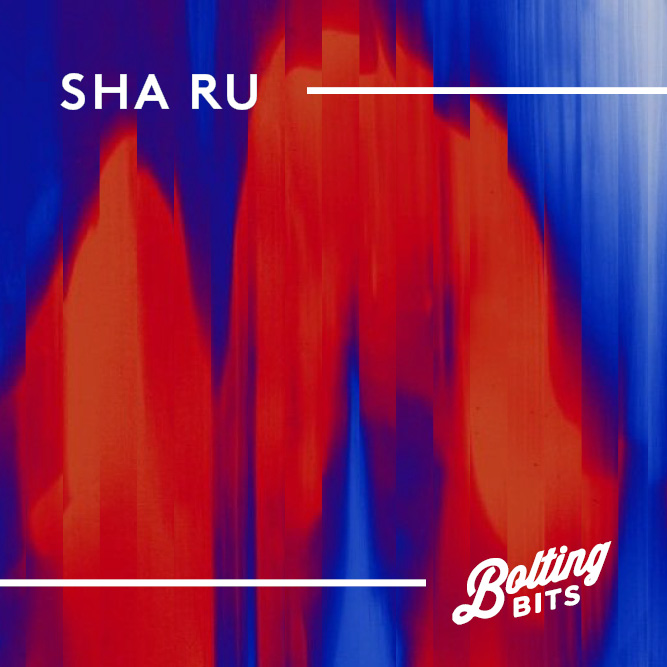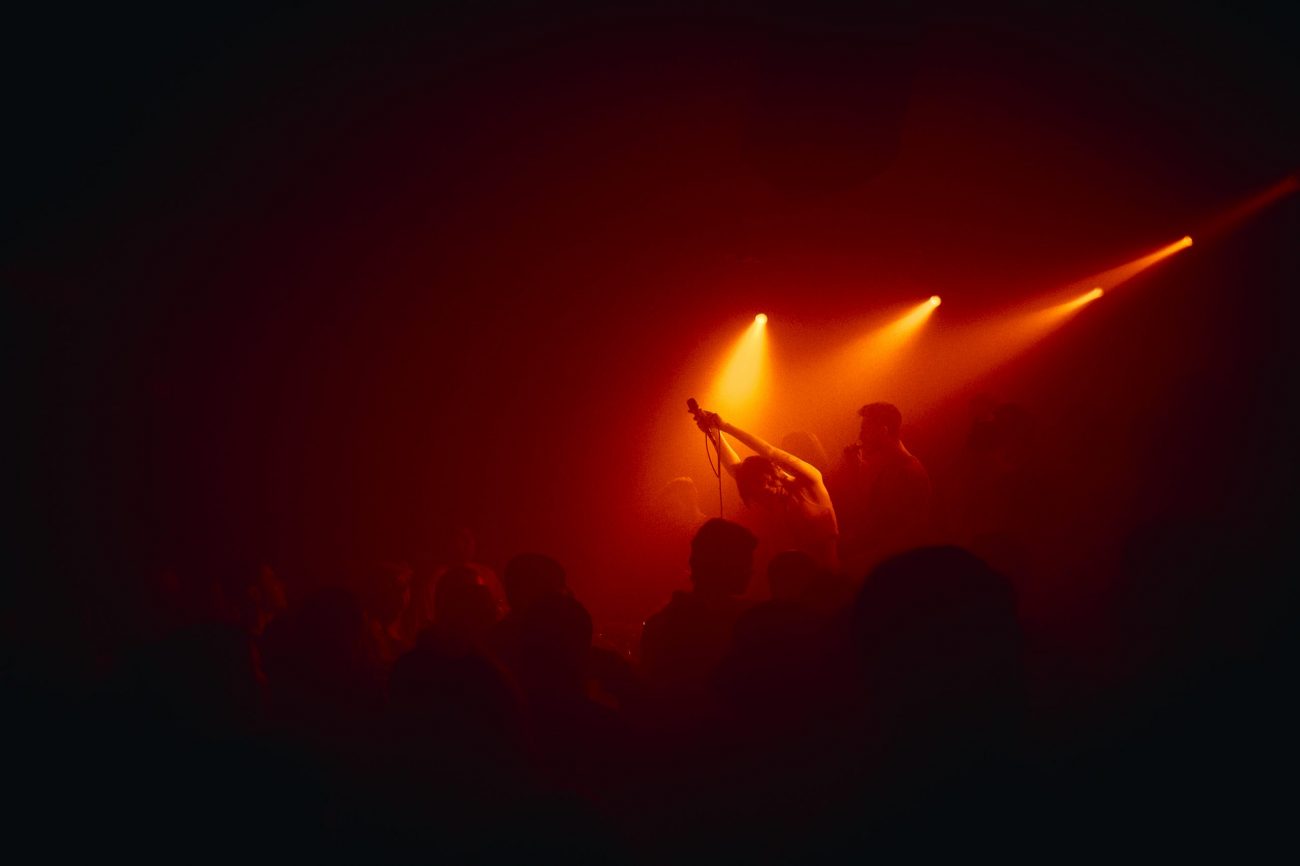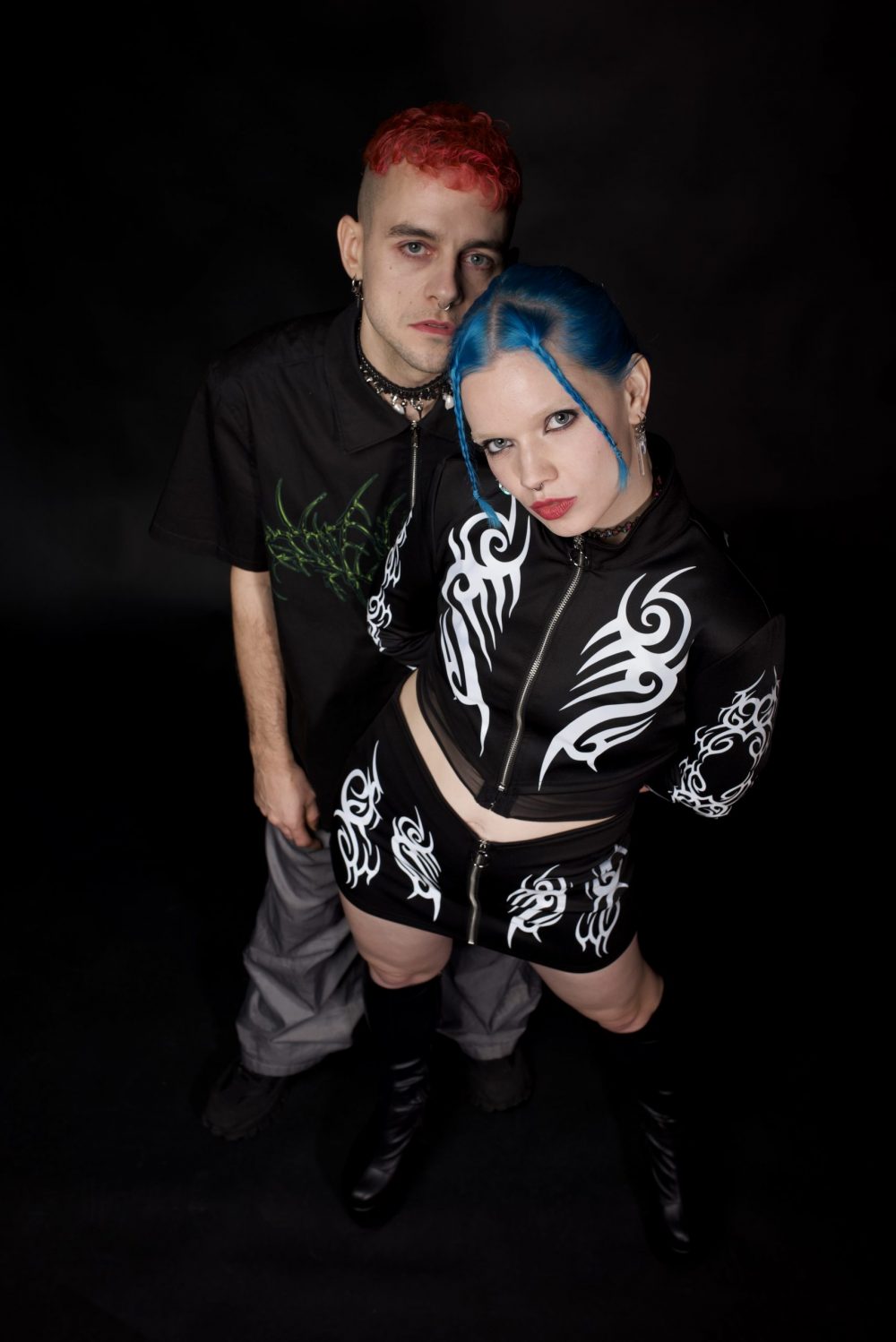
Blending spoken word, heavy bass and club-driven experimentation into something raw, physical and deeply immersive, Sha Ru have carved out a sound that is as cerebral as it is visceral — one that uses low frequencies, texture and space to question how music is felt, not just heard. Their sonic world thrives on contrasts: poetry and pressure, intimacy and intensity, narrative and noise. It’s a language built from the ground up, tuned as much to the body’s response as to the ear’s perception.
With their brand-new self-released EP Vibra Vibra (out October 23), Sha Ru push this philosophy even further. Each track explores how sound ripples through the body and transforms space: sub-bass compressing the chest, subterranean frequencies grounding the gut, buzzing waves pulsing through the skull. It’s a work that positions bass as architecture — a tangible force shaping bodies and rooms alike — and in doing so, it reimagines the dancefloor as a deeply physical environment.
To mark the release, Sha Ru join our MIXED BY series with both an exclusive mix and an in-depth conversation. Across the interview below, the duo dive into the sonic science behind Vibra Vibra, the collaborative dynamic that powers their work, and the political and poetic dimensions that run through their art. Then, in the mix, they extend that exploration into a hypnotic, body-centric journey — a sonic landscape built to be felt in every cell as much as heard in every ear.
INTERVIEW

©CesarBurton
Can you describe the creative roles inside the duo — how do Ma Sha and Rù divide songwriting, vocal production, sound design and DJ/live performance decisions? How do your different origins (breakdancing/NYC / rural Italy production background) inform that partnership?
Our process usually starts with one of us putting down an idea, and then we session together to work out the concept. Sometimes vocals spark the track, sometimes they finalize it. Each of us has our strengths: one is more focused on basslines and rhythmic patterns, the other on sound design and composition. Over time, we’ve built a lot of trust, which means we’re not precious about ideas — if something doesn’t fit, it can be overwritten or deleted, and we move on.. Masha’s dance background makes her very attentive to the overall flow and physical impact of a track, while Ru’s band background brings a jam-based, intuitive way of kickstarting ideas. That mix keeps the process fluid and balanced.
Vibra Vibra frames bass as a tactile material and explicitly maps frequency bands to bodily zones (e.g., the EP text talks about 20–40Hz resonating the abdomen and 50–60Hz compressing the chest). How literal is that mapping in the studio — was it research-led, experimental, or mostly bodily trial-and-error?
It’s mostly rooted in bodily experience and performance feedback. We’ve learned a lot through touring — feeling how frequencies hit us on different sound systems and watching how crowds physically respond. We did read up on frequency ranges and how they affect different body zones, but the mapping became real through testing: pushing 20–40Hz and feeling it in the legs and gut, 50–60Hz compressing the chest, 60–100Hz buzzing in the skull. It’s not about clinical precision, but about using those zones as guides to shape a tactile experience. On top of that, every room and sound system resonates differently, so it’s also about playing the tracks out and noticing how each space produces its own unique physical response.
The EP tracklist (e.g. “Hz Bath”, “Vibrasum”, “Above, Below, Around”) reads like a sonic anatomy — can you walk me through one track (pick whichever you prefer) and explain how you translated an intended physical sensation into arrangement, bass choice and spatial mixing?
Take “Hz Bath,” for example. The idea was to create an enveloping low-end experience, like submerging yourself in vibrating water. The track features a sliding sub bassline that moves from top to bottom, giving the sensation of descending and fully immersing yourself. It also sets the tone for the tonal exploration that unfolds across the rest of the EP. On top of that, it allows us to analyze how different low frequencies resonate in the space and interact with the specific sound system we’re using. Spatially, we used wide stereo fields for the upper layers while keeping the subs tightly centered, so it feels as if the room itself is moving around a grounded core.
Spoken word is a prominent strand of your sound. Do you treat voice primarily as narrative (text + meaning) or as an additional percussive/sonic element? How do you decide what to leave intelligible vs. what to process into texture?
That’s a great question! It shifts over time. Our first EP used vocals mostly as texture. Later, with “White Red White, Keep Up The Fight,” lyrics became the main message. With Vibra Vibra, we’ve circled back to treating voice more texturally again — it’s less about storytelling and more about how vocal sounds interact with bass and space. Only one track, “Above, Below, Around,” uses full lyrics; elsewhere, the voice acts like another instrument in the frequency architecture.
On a technical level: when you design those low-end pressure waves, what tools and techniques are your go-tos for subs and low-mid control (synthesis, filtering, multiband compression, physical sub treatment)? The press credits Ten Eight Seven for mastering — how collaborative was the master process to preserve intended tactile effects?
We rely a lot on clean synthesis for the sub — mostly sine or triangle waves, carefully layered and filtered. On this EP, we also experimented quite a bit with parallel compression, limiting, and saturation. Since our “studio” often fits into our luggage, we don’t have a fixed room to work in, so a lot of fine-tuning happens during sound checks on real systems.

©Karla-Del-Orbe
What’s the gap between how a track feels in your studio monitors vs. a club system? Do you ever design separate versions (edits, VIPs) specifically to hit certain body zones in a club? How do you test venue playback to ensure the physical mapping carries over?
There’s always a gap, especially since we work in temporary setups. Instead of making separate club edits, we rely on testing tracks during sound checks on tour. That’s where we fine-tune how the frequencies behave in different spaces. It’s less about creating “VIPs” and more about iterating in real time and letting the system guide us. Also, the low-end reach of sound systems varies a lot, especially since most clubs focus on house and techno and don’t usually have such a deep extension. Finding a system that can actually go down to 20–30Hz in a club is pretty rare. So maybe some of this music is written for the sounds of the future :) or just meant to be enjoyed on different devices.
Listening to earlier releases (e.g. They Are Textural, Time Turns Liquid) you move between post-punk, hardcore textures and deep bass club forms. Was Vibra Vibra a continuation of that trajectory or a deliberate stylistic detour? What previous techniques or themes carried over?
It’s definitely a continuation. Deep low-end has always been the backbone of our sound, and you can hear dubstep, jungle and experimental tones running through the EP. What’s shifted is the role of vocals — we’ve moved back to using them texturally, which connects to our earliest work, while still keeping that raw, bass-heavy energy.
The artwork credit lists BUBU and your own involvement — how important are visuals for Vibra Vibra? Do you conceive mixes/EPs as audiovisual pieces where the artwork, staging and sound form a single organism?
Visuals are crucial for us. Since the beginning, we’ve treated each release as an audiovisual organism. For Vibra Vibra, we focused on capturing the body in an abstract way — no faces, unlike our previous covers — to let vibration itself become the central motif. We wanted the artwork to feel like another layer of the frequencies.
For the MIXED BY set: will you approach it as an extension of Vibra Vibra (keeping tactile low-end and spoken elements front and centre), or do you plan to present a wider portrait of Sha Ru’s influences and club edits? Any technical tricks you plan to use in the mix (heavy layering of subs, live voice samples, EQ automation) to recreate that bodily experience for listeners at home? (If you want, we can publish a short “mix notes” block explaining these choices for readers.)
For this mix, we aimed to capture a feeling similar to Vibra Vibra. We open with the first track from our upcoming EP, Hz Bath, and then dive into heavy bass tunes that highlights different frequencies and rhythms. To give the mix a rawer edge, we layered some transitions with a dub delay.
You’ve released on labels like Jupiter4, Woozy and others and self-released this series — what’s your thinking around labels vs self-release for a concept like Vibra Vibra? Did self-releasing let you keep conceptual control over mastering/packaging?
This is our first self-released EP since 2021, and it feels exciting to return to a DIY approach. We love working with labels and are grateful for every collaboration, but self-releasing gives us full conceptual control — from mastering to packaging — which suits a project this focused on tactile sound and personal vision.

